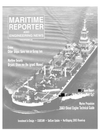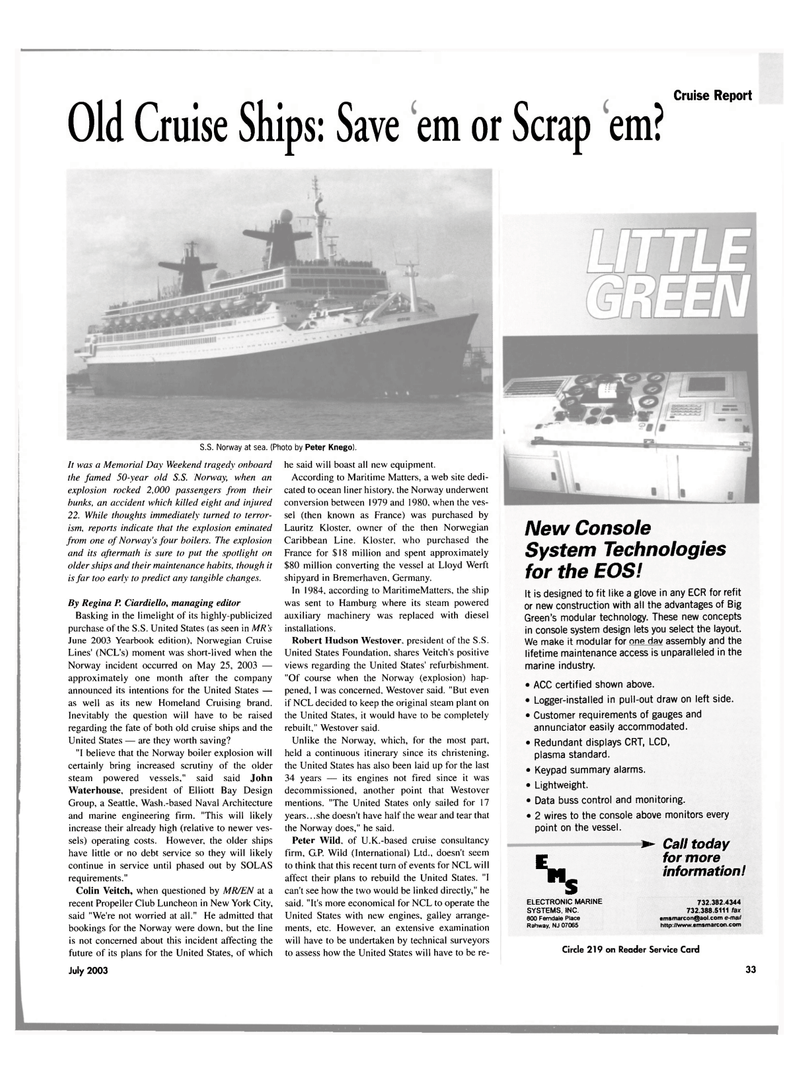
Page 31: of Maritime Reporter Magazine (July 2003)
Read this page in Pdf, Flash or Html5 edition of July 2003 Maritime Reporter Magazine
Old Cruise Ships: Save em or Scrap em? Cruise Report
S.S. Norway at sea. (Photo by Peter Knego).
It was a Memorial Day Weekend tragedy onboard the famed 50-year old S.S. Norway, when an explosion rocked 2,000 passengers from their bunks, an accident which killed eight and injured 22. While thoughts immediately turned to terror- ism, reports indicate that the explosion eminated from one of Norway's four boilers. The explosion and its aftermath is sure to put the spotlight on older ships and their maintenance habits, though it is far too early to predict any tangible changes.
By Regina P. Ciardiello, managing editor
Basking in the limelight of its highly-publicized purchase of the S.S. United States (as seen in MR's
June 2003 Yearbook edition), Norwegian Cruise
Lines' (NCL's) moment was short-lived when the
Norway incident occurred on May 25, 2003 — approximately one month after the company announced its intentions for the United States — as well as its new Homeland Cruising brand.
Inevitably the question will have to be raised regarding the fate of both old cruise ships and the
United States — are they worth saving? "I believe that the Norway boiler explosion will certainly bring increased scrutiny of the older steam powered vessels." said said John
Waterhouse, president of Elliott Bay Design
Group, a Seattle, Wash.-based Naval Architecture and marine engineering firm. "This will likely increase their already high (relative to newer ves- sels) operating costs. However, the older ships have little or no debt service so they will likely continue in service until phased out by SOLAS requirements."
Colin Veitch, when questioned by MR/EN at a recent Propeller Club Luncheon in New York City, said "We're not worried at all." He admitted that bookings for the Norway were down, but the line is not concerned about this incident affecting the future of its plans for the United States, of which
July 2003 he said will boast all new equipment.
According to Maritime Matters, a web site dedi- cated to ocean liner history, the Norway underwent conversion between 1979 and 1980, when the ves- sel (then known as France) was purchased by
Lauritz Kloster, owner of the then Norwegian
Caribbean Line. Kloster, who purchased the
France for $18 million and spent approximately $80 million converting the vessel at Lloyd Werft shipyard in Bremerhaven, Germany.
In 1984, according to MaritimeMatters, the ship was sent to Hamburg where its steam powered auxiliary machinery was replaced with diesel installations.
Robert Hudson Westover. president of the S.S.
United States Foundation, shares Veitch's positive views regarding the United States' refurbishment. "Of course when the Norway (explosion) hap- pened, I was concerned. Westover said. "But even if NCL decided to keep the original steam plant on the United States, it would have to be completely rebuilt," Westover said.
Unlike the Norway, which, for the most part, held a continuous itinerary since its christening, the United States has also been laid up for the last 34 years — its engines not fired since it was decommissioned, another point that Westover mentions. "The United States only sailed for 17 years... she doesn't have half the wear and tear that the Norway does," he said.
Peter Wild, of U.K.-based cruise consultancy firm, G.P. Wild (International) Ltd., doesn't seem to think that this recent turn of events for NCL will affect their plans to rebuild the United States. "I can't see how the two would be linked directly," he said. "It's more economical for NCL to operate the
United States with new engines, galley arrange- ments, etc. However, an extensive examination will have to be undertaken by technical surveyors to assess how the United States will have to be re-
New Console
System Technologies for the EOS!
It is designed to fit like a glove in any ECR for refit or new construction with all the advantages of Big
Green's modular technology. These new concepts in console system design lets you select the layout.
We make it modular for one day assembly and the lifetime maintenance access is unparalleled in the marine industry. • ACC certified shown above. • Logger-installed in pull-out draw on left side. • Customer requirements of gauges and annunciator easily accommodated. • Redundant displays CRT, LCD, plasma standard. • Keypad summary alarms. • Lightweight. • Data buss control and monitoring. • 2 wires to the console above monitors every point on the vessel. » Call today for more information! S
ELECTRONIC MARINE
SYSTEMS. INC. 800 Femdale Place
Rahway. NJ 07065 732.382.4344 732.388.5111 fa* [email protected] e-mail http://www.emsmarcon.com
Circle 219 on Reader Service Card 33

 30
30

 32
32
